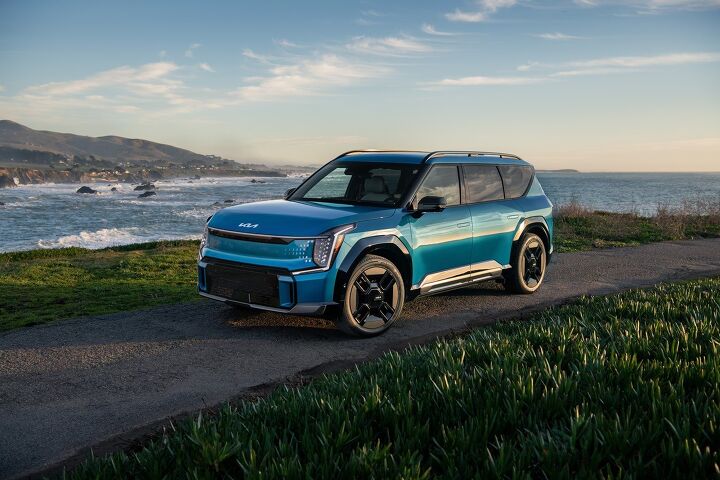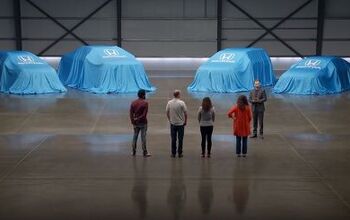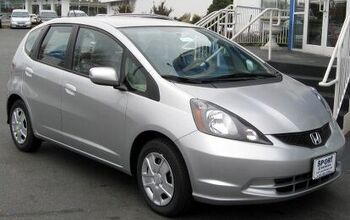What Kind of Cars Do Women Actually Want?

On International Women’s Day, the Kia EV9 was announced as the “Supreme Winner” of the Women's Worldwide Car of the Year (WWCOTY) 2024. However, saying that this is the vehicle women most desire — let alone are willing to spend money buying — is probably a stretch.
Despite often being framed as though there’s some colossal demographic consensus, plenty of awards are effectively decided by a small number of handpicked judges that are supposed to represent the larger group. In this case it was 75 female automotive journalists from 52 different countries. That effectively precludes any vehicles that are not intended for the global market, with winners resulting from the opinions of a limited number of industry experts.
These women also decided that the Volvo EX30 was the “Best Family Car,” the BMW 5 Series served as the “Best Large Car”, and that the Volkswagen Amarok ended up being the “Best 4x4 or Pick-up.” The Aston Martin DB12 also received an award for “Best Exclusive Car,” even though I’ve never seen a woman driving an Aston Martin in my entire life.
"This year's election was particularly difficult due to the excellent level of all the candidates," stated Marta Garcia, executive president of WWCOTY. "Each of the finalists had sufficient merit to win the trophy. The Kia EV9 has won out over its rivals because it is a vehicle capable of satisfying the needs of consumers everywhere."
The EV9 apparently took away the win due to the fact that the model was feature rich and allegedly brought electric vehicles to a point where at least some of the judges believed it surpassed combustion vehicles in terms of overall convenience and capability. Women also seemed to appreciate its novel design and how the cabin was oriented.
“The Kia EV9 is truly a game-changer for electric vehicles. It will be the vehicle we look back on down the road and say ‘that is when EVs became truly affordable, user-friendly and desirable for all consumers’. No other vehicle has taken the same risks and pushed the design and engineering boundaries to the same limit,” said Tanya Gazdik.
Details about why the other models were selected were rather sparse. However, common themes seemed to be the availability of electrified powertrains, engaging designs, and a bevy of features. Though it was hardly a buffet of information.
Perhaps there is more to learn if we slather on some more data about female motorists. According to S&P Global Mobility, Buick was the brand that had the highest percentage of female customers with a 55-percent share at the start of 2023. While Mitsubishi, Mini, and Lexus also had a majority of women customers, the difference was so slight that it could be attributed to even the slightest margin of error.
Sadly, it’s harder to break gender preference down by model. Most of the relevant studies are several years old, frequently rope in the European market, and typically list high-volume models that are purchased by just as many men (e.g. Honda Civic). However, assuming their purchasing trends have remained consistent since roughly 2018, there are a few obvious takeaways. Women tend to buy smaller vehicles boasting lower MSRPs than their male counterparts. As of 2021, they were also more prone to head to the used market and decidedly less inclined to buy something brand new.
In 2019, Cars.com published a list of vehicles most frequently purchased by each gender. But there was so much overlap that it’s really only worth focusing on the differences. Men gravitated toward pickups, larger SUVs, and the occasional muscle cars. Meanwhile, women ignored trucks and frequently opted for something less financially cumbersome. Both liked crossovers and high-volume Japanese sedans. But women tended to prefer their crossovers a tad smaller and didn’t mind having the occasional Nissan Altima or Chevrolet Malibu in the driveway — likely because they tend to sticker rather low vs the competition.
Then there are the models that don’t exactly top the sales charts but are culturally synonymous with women. Despite only having a slight bend toward female buyers globally, Mini products are often seen as feminine and are overwhelmingly bought by women in places like China. At one point, the brand was seeing an 80 percent breakdown in favor of ladies living in Central Asia and started worrying it might be a problem.
Back in the United States, we watched Subaru accomplish the inverse by turning female customers into a boon. Noticing a declining market share in the 1990s, Subaru elected to re-target the niche markets that offered it secure footing upon its regional launch. This just meant focusing on outdoorsy types with a penchant for smaller vehicles.
Back then, I knew several female couples that exclusively owned Subaru products. Today, just about every female driver I know sees it as a reputable brand with a quality ethos. It’s invariably mentioned whenever they ask me about what their next vehicle should be. My assumption is that this has been the result of smart packaging and clever marketing. Subaru also didn’t turn away male customers, even courting them through its involvement with motorsport, with Subaru’s North American volumes absolutely exploding after the 1990s.
Despite numerous data sets suggesting that a majority of car brands skew toward having male buyers, Cars.com released a 2019 report stipulating that roughly 62 percent of all car buyers were female. It likewise asserted that over 85 percent of all vehicle purchases made in the United States were meaningfully influenced by a woman.
However there doesn’t really seem to be any grand consensus regarding what women like. But it’s not for a lack of trying and numerous manufacturers have engaged in design studies hoping to cater to female tastes. That said, those vehicles don’t have a good track record of staying on the market.
In the early 1900s, the Broc Electric Vehicle Company was marketing some of the earliest all-electric vehicles to women. The assumption was that ladies would have an easier time operating its basic controls and could use the small conveyance as an urban runabout. However, the concept didn’t last for long and the brand died in 1916.
The company probably should have known better. The Baker Motor Vehicle Company tried something similar years earlier and pivoted hard toward marketing to women (particularly upper-crust ladies) in its last gasps. Despite receiving healthy amounts of praise for offering novel designs that were praised as cleaner to operate and easier to maintain than combustion models, the company went defunct in 1914.
In the post-war period, we saw the 1955 Dodge La Femme. Based on the Custom Royal Lancer, the vehicle was little more than an appearance package designed to cater to cliched notions of femininity. It was an abject failure for the company. But GM would attempt something similar every so often.
Over a generation later, Volvo tried its hand by assembling a team of eight female employees from different departments that would oversee prototypes the company was working on. While we cannot say exactly how much their input informed individual models, the concept of Volvo’s “Female Customer Reference Group” actually stuck around after being established in the 1980s.
Sadly, the only car we know for certain where the female crew was heavily involved in planning likewise ended up going nowhere. In 2001, Volvo was lauded for having women involved in the design process and tasked itself with developing a concept car using its all-female team. While small, the group focused on market research to determine what women most wanted from a vehicle and set to work. The public was made aware of the program on International Women’s Day in 2003 and the plan was to unveil the “ Volvo Your Concept Car” (YCC) at the 2004 Geneva Auto Show.
Despite very obviously being a concept vehicle reminiscent of the Volvo Safety Concept Car (SSC), the YCC has loads of intelligent solutions men likely wouldn’t have considered. Headrests had indentations to accommodate pony tails, you could refill the window washer fluid without opening the hood, doors opened automatically, and the car was loaded up with clever storage solutions made at the expense of traditional automotive design. But the YCC never made it to production due to it playing host to technologies that would have made it quite expensive. In the aftermath, Volvo made it pretty clear that it was always supposed to be a concept vehicle. However, much of its novel features have become standard equipment on many modern automobiles.
We also learned that the female team that designed the vehicle never really wanted to make something that appealed specifically to females, even though the marketing and media response often framed the YCC as a car for women. The true goal was to have these women design the best car possible for all drivers, provided they were among them, and that’s probably the most important thing to take away from this entire article.
While there are certainly models that appeal to women, ladies don’t appear to be any more brand loyal than males and actually look a tad more pragmatic when it comes time to actually buy something. Despite likewise being susceptible to targeting advertisements, women don’t seem to care as much about aspirational models and are tougher to upsell. If they’re not positive they’ll need the extra space, they’ll typically opt for something smaller with a lower price tag and are largely disinterested in juicy specifications so long as the test drive feels right.
I can't believe it took us over 100 years to determine women basically want all the same things men do minus the spec sheet.
[Images: Kia; Dodge; Volvo]
Become a TTAC insider. Get the latest news, features, TTAC takes, and everything else that gets to the truth about cars first by subscribing to our newsletter.

A staunch consumer advocate tracking industry trends and regulation. Before joining TTAC, Matt spent a decade working for marketing and research firms based in NYC. Clients included several of the world’s largest automakers, global tire brands, and aftermarket part suppliers. Dissatisfied with the corporate world and resentful of having to wear suits everyday, he pivoted to writing about cars. Since then, that man has become an ardent supporter of the right-to-repair movement, been interviewed on the auto industry by national radio broadcasts, driven more rental cars than anyone ever should, participated in amateur rallying events, and received the requisite minimum training as sanctioned by the SCCA. Handy with a wrench, Matt grew up surrounded by Detroit auto workers and managed to get a pizza delivery job before he was legally eligible. He later found himself driving box trucks through Manhattan, guaranteeing future sympathy for actual truckers. He continues to conduct research pertaining to the automotive sector as an independent contractor and has since moved back to his native Michigan, closer to where the cars are born. A contrarian, Matt claims to prefer understeer — stating that front and all-wheel drive vehicles cater best to his driving style.
More by Matt Posky
Latest Car Reviews
Read moreLatest Product Reviews
Read moreRecent Comments
- Fred No idea why someone would interested in buying this at the price point. I'm pro-ev but a quick search can pull-up a lot more value at lower costs. I like the Fiat design but I couldn't stomach paying $37k for limited range and a super tight back seat.
- 28-Cars-Later For the you-gotta-be-rich-to-afford-a-cheap-car crowd, Versa is the winner here IMO. Buy it new and pay the $300ish (?) note, but enjoy at least five years with relative reliability assuming historical average miles. Based on MY19, Manheim expects the "S" to be worth $5,975 in roughly five years with "retail" value being $12,650. Nissan and other second or third tier marques will give more on a new trade so assuming 20 OTD with incentives its a 12K/$2,400 depreciation over 5 years excluding interest and it probably could be kept another year or two before the Nissan in it starts to show. Mirage in this comparison is the new buy used on the cheap and run it till the wheels fall off. I'm loathe to compare it to either the Panther or 240 (since I don't believe it could physically last as long as either) but something in the vein of car you could repair yourself on the cheap which was originally intended for Third World conditions. Based on MY19, the ES hatch is worth $4K even with avg miles of 72,740 and "retail" value at $9,650. I personally see it as lot poison and could see savvy buyers making off with one of these near or below wholesale while Nissan is a staple of the subprime crowd and is much easier to finance. MC beings up an interesting contender in the used Chevy Bolt, whose wholesale is $12,050 for MY19 in LT trim with avg lower miles of 33,017. While this is very intriguing, financing is going to be the story here since Nissan or I imagine Mitsubishi could put buyers into half decent rates despite poor credit where a Bolt is "going to the street" and getting whatever high rate is being offered now. Assuming one can handle their own charging, Bolt does offer a lower maintenance cost and used I believe buyers have a higher chance of a white collar professional's commuter condition than what they will find in a used Nissan or Mitsu runabout. The risk to our theoretical buyer IMO is that the Bolt will straight up fail at some point in the future, either not take a charge or even turn on and for the higher wholesale entry point I say the Mitsu is a better choice since it likely won't completely fail and can very cheaply be replaced. Additional: For your kid/nephew/niece/any "middle class" child, I think Bolt is probably the better proposition here but I'd be out of the trade in 36 mos personally. For those truly on their own with no emergency support system, I'd shy away.
- Jbltg It's interesting to note that in the Japan domestic market, where cars are built to order and dealers maintain barely any stock, that there are many, many color options. Really good ones, but no one seems to bite. Most of the cars on the road there are the same boring colors that we have. Go figure.My pet peeve is black interiors. Too depressing, and shows every speck of dust and dirt.
- IBx1 Dealerships flood the market with grayscale cars to commodify them and drive down resale value. Green and yellow cars hold their value best because they cannot easily be replaced, but you can throw a rock and hit fifty shades of gray.
- SCE to AUX Appliances (household and vehicular) have limited color choices, that's why.But today, if you want a crazy color, just buy a plain one and get it wrapped.





































Comments
Join the conversation
How was Camry not once mentioned here? Just goes to show what the type of naked men here actually know about women.
"Women represent 50 per cent of the drivers on the road and are said to decide the majority of vehicle purchases.
Yet when they get behind the wheel there is nowhere to put a purse."